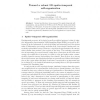22 search results - page 3 / 5 » Top-Down Control of Learning in Biological Self-Organizing M... |
SASO
2008
IEEE
13 years 11 months ago
2008
IEEE
—High level languages greatly increase the power of a programmer at the cost of programs that consume more s than those written at a lower level of abstraction. This inefficienc...
EVOW
2008
Springer
13 years 7 months ago
2008
Springer
We present a study on the use of soft computing techniques for object tracking/segmentation in surveillance video clips. A number of artificial creatures, conceptually, "inhab...
AR
2008
13 years 5 months ago
2008
Intentional behavior is a basic property of intelligence and it incorporates the cyclic operation of prediction, testing by action, sensing, perceiving, and assimilating the exper...
ISVC
2010
Springer
13 years 3 months ago
2010
Springer
In this paper, we propose an automatic learning method for gesture recognition. We combine two different pattern recognition techniques: the SelfOrganizing Map (SOM) and Support Ve...
ESANN
2007
13 years 6 months ago
2007
Abstract. Several models have been proposed for spatio-temporal selforganization, among which the TOM model by Wiemer [1] is particularly promising. In this paper, we propose to ad...

